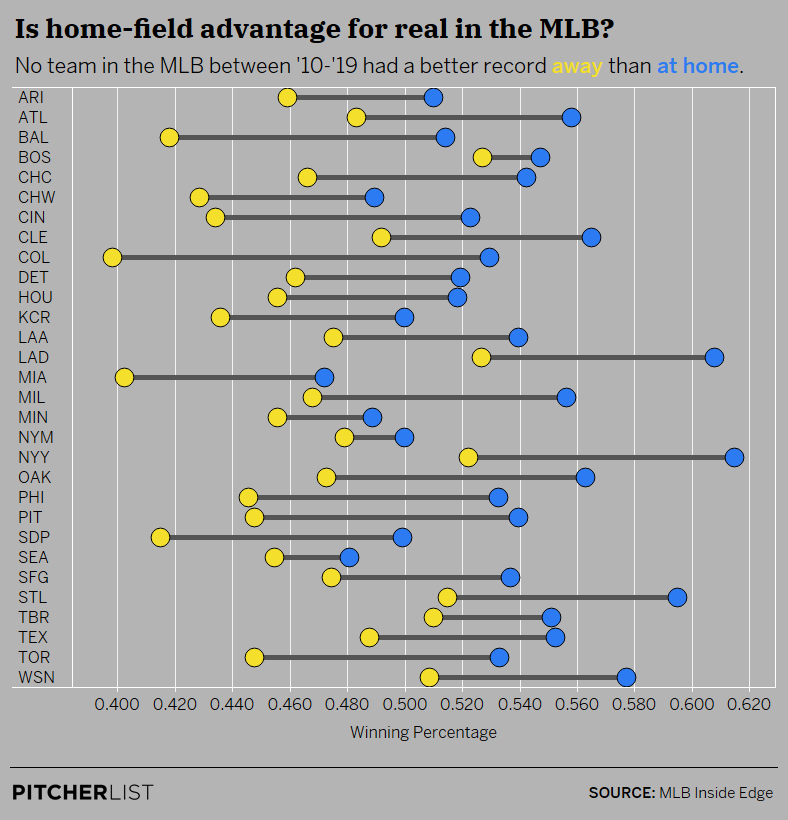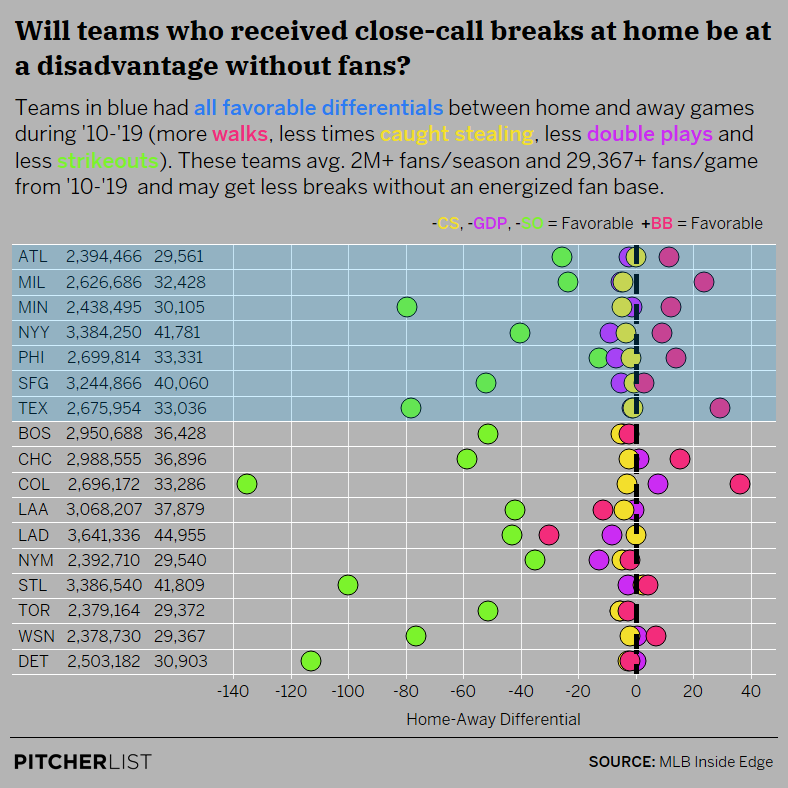After months of waiting, the 2020 MLB season is finally set to kick off. Though the excitement level among the baseball world is relatively high, much attention has been focused on how to make empty stadiums feel… not so barren.
Today, however, our attention will slightly shift away from the unique ways in which organizations are filling their stadiums — with artificial noise and crowds — and we’ll set our sights on the impact these empty buildings will have on a shortened 60-game season. In short, we’ll attempt to determine which teams benefit the most/least from playing in empty stadiums and why.
I collected a variety of data, the most obvious of which was the attendance record for every MLB team during the years 2010-2019. I then collected each team’s home and away record for the aforementioned years. This is what I found.

Data Visualization by Nick Kollauf (@Kollauf on Twitter)
Immediately, I was struck by the fact that no team had a better away record than a home record. None. What’s more, only five teams averaged a sub-.500 record at home during that 10-year span (Padres, White Sox, Twins, Mariners, and Marlins), while only six teams averaged an away record better than .500 (Red Sox, Dodgers, Yankees, Cardinals, Rays, Nationals). Not surprisingly, the three teams with the best home record also happen to have the highest attendance record (Dodgers, Yankees, Cardinals).
This made it clear that home teams definitely have an advantage. It also made me curious to see what the numbers looked like if we were to zoom in a little bit and break things down on a game-by-game basis rather than a decade-long stretch. With the assistance of one of our superb data science people, Eric Colburn, I looked at over 12,000 games between 2015 and 2019 and found that the home team possesses a W-L% close to 100 points higher during that 5-year span.
| Wins | Losses | Win% |
|---|---|---|
| 6,578 | 5,745 | 0.546 |
Now, that doesn’t really address the question of how attendance impacts teams, so we decided to break the numbers down even further. After taking each individual team’s attendance record for every game between 2015-2019, we attempted to quantify the impact it had on said games. What we found is that there is a correlation between attendance and wins. In other words, the more people that attend games, the likelier the team is to win.
| Up to % of Att | # of Games | # of Home Wins | Home W% |
|---|---|---|---|
| 0 (Not Counted) | 4858 | 2571 | |
| 25% | 35 | 14 | 40% |
| 35% | 319 | 163 | 51.10% |
| 45% | 630 | 326 | 51.75% |
| 55% | 951 | 498 | 52.37% |
| 65% | 1032 | 517 | 50.10% |
| 75% | 1094 | 578 | 52.83% |
| 85% | 1073 | 616 | 57.41% |
| 95% | 1045 | 600 | 57.42% |
| 105% | 1286 | 695 | 54.04% |
Now comes the hard part: the why.
When sifting through all the reasons why the home team has such a distinct advantage, the one in which we can quantify most efficiently is umpire bias. Why would an umpire make biased calls in favor of the home team? Well, the most obvious answer has to be fan support.
To show this, I collected some more stats that aren’t so black and white and require judgment on behalf of the umpire.
- Caught Stealing (CS)
- Strikeouts (SO)
- Walks (BB)
- Double Plays Grounded Into (GDP)
The rationale behind looking at these stats is to see if they’re skewed in favor of the home team. This might indicate that fan support influenced the umpire’s call. These stats go both ways — all calls, whether the home team is batting or fielding, are included. Not surprisingly, the data shows that these calls tend to favor the home team over the away team… in a pretty big way.
| Attend | Attend/G | HW-L% | AW-L% | H-SO | A-SO | H-BB | A-BB | H-CS | A-CS | H-GDP | A-GDP | H-RS | A-RS | |
|---|---|---|---|---|---|---|---|---|---|---|---|---|---|---|
| LAD | 3,641,336 | 44,955 | 0.608 | 0.527 | 607 | 650 | 260 | 290 | 16.7 | 16.7 | 56 | 64 | 343 | 373 |
| STL | 3,386,540 | 41,809 | 0.595 | 0.515 | 559 | 659 | 266 | 262 | 17.6 | 15.1 | 64 | 67 | 362 | 376 |
| NYY | 3,384,250 | 41,781 | 0.615 | 0.522 | 603 | 643 | 285 | 276 | 11.8 | 15.4 | 56 | 65 | 408 | 383 |
| SFG | 3,244,866 | 40,060 | 0.537 | 0.475 | 575 | 627 | 238 | 235 | 16.8 | 17.5 | 60 | 65 | 311 | 350 |
| LAA | 3,068,207 | 37,879 | 0.540 | 0.475 | 563 | 605 | 239 | 251 | 16.1 | 20.3 | 65 | 66 | 345 | 375 |
| CHC | 2,988,555 | 36,896 | 0.543 | 0.466 | 645 | 704 | 269 | 254 | 14.6 | 17.1 | 59 | 58 | 361 | 345 |
| BOS | 2,950,688 | 36,428 | 0.547 | 0.527 | 587 | 639 | 271 | 273 | 11.2 | 16.5 | 63 | 68 | 426 | 384 |
| PHI | 2,699,814 | 33,331 | 0.533 | 0.446 | 630 | 643 | 250 | 236 | 12.6 | 14.3 | 53 | 60 | 352 | 326 |
| COL | 2,696,172 | 33,286 | 0.530 | 0.398 | 587 | 722 | 259 | 222 | 17.7 | 20.7 | 63 | 55 | 473 | 302 |
| TEX | 2,675,954 | 33,036 | 0.552 | 0.488 | 574 | 652 | 260 | 231 | 21.1 | 22.3 | 58 | 60 | 421 | 347 |
| MIL | 2,626,686 | 32,428 | 0.556 | 0.468 | 656 | 680 | 264 | 241 | 16.4 | 20.8 | 58 | 63 | 369 | 342 |
| DET | 2,503,182 | 30,903 | 0.519 | 0.462 | 565 | 678 | 240 | 242 | 13.6 | 16.2 | 67 | 67 | 376 | 345 |
| MIN | 2,438,495 | 30,105 | 0.489 | 0.456 | 587 | 667 | 265 | 253 | 13.5 | 18.4 | 57 | 58 | 371 | 363 |
| ATL | 2,394,466 | 29,561 | 0.558 | 0.483 | 624 | 649 | 271 | 259 | 16.5 | 16.6 | 60 | 63 | 350 | 341 |
| NYM | 2,392,710 | 29,540 | 0.500 | 0.479 | 620 | 655 | 260 | 262 | 13.5 | 18.3 | 52 | 65 | 315 | 368 |
| TOR | 2,379,164 | 29,372 | 0.533 | 0.448 | 605 | 657 | 260 | 263 | 12.1 | 17.5 | 60 | 66 | 381 | 362 |
| WSN | 2,378,730 | 29,367 | 0.577 | 0.509 | 606 | 683 | 267 | 260 | 15.0 | 16.9 | 57 | 57 | 372 | 356 |
| SDP | 2,227,518 | 27,500 | 0.499 | 0.415 | 675 | 703 | 255 | 228 | 18.9 | 19.9 | 53 | 54 | 304 | 326 |
| HOU | 2,211,175 | 27,298 | 0.519 | 0.456 | 635 | 648 | 251 | 245 | 18.9 | 21.1 | 60 | 67 | 351 | 361 |
| CIN | 2,117,870 | 26,147 | 0.523 | 0.434 | 646 | 645 | 264 | 246 | 18.7 | 21.9 | 51 | 61 | 363 | 336 |
| ARI | 2,117,731 | 26,145 | 0.510 | 0.459 | 654 | 683 | 268 | 253 | 17 | 19 | 57 | 60 | 385 | 350 |
| SEA | 2,021,791 | 24,960 | 0.481 | 0.455 | 659 | 641 | 243 | 234 | 18.1 | 19.0 | 58 | 55 | 307 | 349 |
| PIT | 1,996,917 | 24,653 | 0.540 | 0.448 | 581 | 695 | 238 | 244 | 20.7 | 21.5 | 60 | 59 | 331 | 340 |
| BAL | 1,976,673 | 24,403 | 0.514 | 0.418 | 599 | 682 | 221 | 213 | 11.0 | 13.0 | 65 | 66 | 366 | 337 |
| KCR | 1,941,827 | 23,973 | 0.500 | 0.436 | 506 | 600 | 210 | 205 | 18.8 | 20.3 | 68 | 65 | 347 | 335 |
| CHW | 1,797,085 | 22,186 | 0.489 | 0.428 | 625 | 649 | 228 | 201 | 19.9 | 22.7 | 57 | 66 | 343 | 336 |
| CLE | 1,654,045 | 20,420 | 0.565 | 0.492 | 588 | 621 | 278 | 266 | 16.0 | 17.5 | 59 | 61 | 373 | 355 |
| OAK | 1,638,835 | 20,233 | 0.563 | 0.473 | 577 | 653 | 273 | 263 | 13.1 | 14.6 | 60 | 65 | 359 | 367 |
| MIA | 1,525,358 | 18,832 | 0.472 | 0.402 | 622 | 678 | 242 | 222 | 14.9 | 17.6 | 62 | 64 | 317 | 319 |
| TBR | 1,407,118 | 17,372 | 0.551 | 0.510 | 657 | 674 | 278 | 266 | 20.9 | 21.3 | 52 | 64 | 336 | 365 |
| AVG | 2,416,125 | 29,829 | 0.535 | 0.466 | 607 | 659 | 256 | 247 | 16.1 | 18.3 | 59 | 62 |
I looked to see how many teams have more strikeouts at home than away and was surprised to find that only two of 30 teams average more strikeouts in their friendly confines vs. on the road (the Mariners and Reds). At the same time, only seven of 30 teams walk more in away stadiums than at home (the Dodgers, Angels, Pirates, Blue Jays, Red Sox, Mets, and Tigers). This would indicate that the home team receives more favorable balls/strikes calls from umpires.
Comparing caught stealing stats between home and away teams found that just one team averaged more CS at home than away (the Cardinals). The stolen base is a dying art form in the game of baseball, and often this “bang-bang” play is left to the judgment of the umpire. Surprisingly, even in the replay era, the stat favors the home team. Speaking of “bang-bang” plays, only five teams grounded into more double plays at home than away (the Rockies, Royals, Seattle, Pirates, and Cubs).
What Role Will Empty Stadiums Play in 2020?
Some teams will benefit more from playing in empty stadiums, especially in a 60-game season where the implications of every game could be huge.
Of course, the most important component to having a successful season deals with the level of talent the front office manages to accrue. However, the smattering of “breaks” a team can get from an energized fan base could make or break a shortened season.
So, in looking at the vast information collected, I have determined that the following teams benefit the most from playing in empty stadiums:
- Cleveland Indians
- Oakland Athletics
- Tampa Bay Rays
These three teams averaged top-10 home records while posting average attendance records in the bottom four during the years 2010-2019, which would indicate that they continue winning games despite a weak attendance record.
| Team | Avg Home Att | Home Win% |
|---|---|---|
| Cleveland | 20,420 | 0.565 |
| Oakland | 20,244 | 0.563 |
| Tampa Bay | 17,372 | 0.551 |
Conversely, the following teams benefit the least from playing in empty stadiums:
- Atlanta Braves
- Milwaukee Brewers
- Minnesota Twins
- New York Yankees
- Philadelphia Phillies
- San Francisco Giants
- Texas Rangers
All five of these teams average at least two million fans per season and 29,367 or more fans per game between 2010-2019. These teams post significantly better home records than away records while also seeing fewer calls (CS, SO, BB, GDP) go against them at home.

Now, this isn’t to say that these teams are doomed for the 2020 MLB season. Neither am I saying with 100% certainty that the Indians, A’s, and Rays will run away with their respective divisions. Instead, what this illustrates is that home teams will likely not get the benefit of the doubt in close calls because they won’t have the immediate support of fans pressuring umpires.
There’s no question that this season MLB games will look different aesthetically. It turns out they’ll feel different too, especially for those whose job it is to perform on the field.
Featured image by Justin Paradis (@freshmeatcomm on Twitter)

